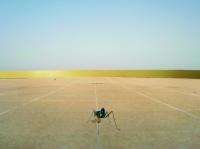No place like home: Ant navigation skills used in robot navigation

Next time you find yourself lost despite having a map and satellite navigation, spare a thought for the unfortunate ant that must take regular trips home to avoid losing its way.
Dr Markus Knaden, from the University of Zurich, reports that a visit back to the nest is essential for ants to reset their navigation equipment and avoid getting lost on foraging trips.
"Knowledge about path integration and landmark learning gained from our experiments with ants has already been incorporated in autonomous robots. Including a 'reset' of the path integrator at a significant position could make the orientation of the robot even more reliable", says Dr Knaden who will speak on Tuesday 4th April at the Society for Experimental Biology's Main Annual Meeting in Canterbury, Kent.
Ants that return from foraging journeys can use landmarks to find their way home, but in addition they have an internal backup system that allows them to create straight shortcuts back to the nest even when the outbound part of the forage run was very winding. This backup system is called the 'path integrator' and constantly reassesses the ant's position using an internal compass and measure of distance travelled. Knaden and his colleagues hypothesised that because the path integrator is a function of the ant's brain, it is prone to accumulate mistakes with time. That is, unless it is regularly reset to the original error-free template; which is exactly what the researchers have found.
When they moved ants from a feeder back to a position either within the nest or next to the nest, they found that only those ants that were placed in the nest were able to set off again in the right direction to the feeder. Those left outside the nest set off in a feeder-to-home direction (i.e. away from the nest in completely the opposite direction to the source of food) as if they still had the idea of 'heading home' in their brains. "We think that it must be the specific behaviour of entering the nest and releasing the food crumb that is necessary to reset the path integrator", says Knaden. "We have designed artificial nests where we can observe the ants after they return from their foraging trips in order to test this."
What next? The group plan to study other ant species that live in landmark rich areas. "Maybe we will find that such ants rate landmarks more highly and use them, not the nest, to reset the path integrator", explains Knaden.
Source: Society for Experimental Biology
















